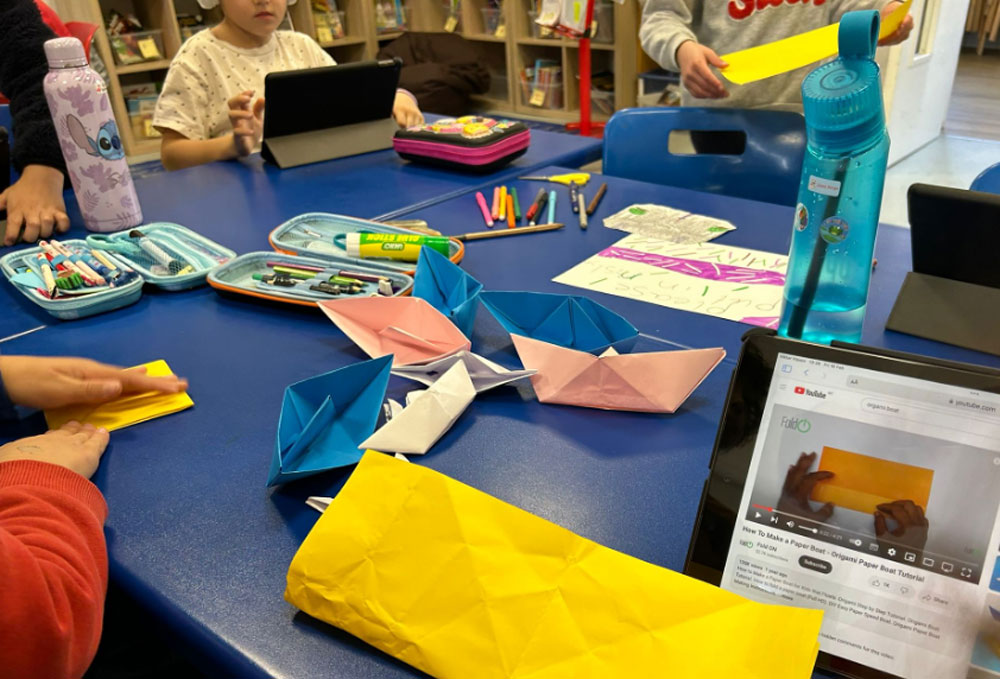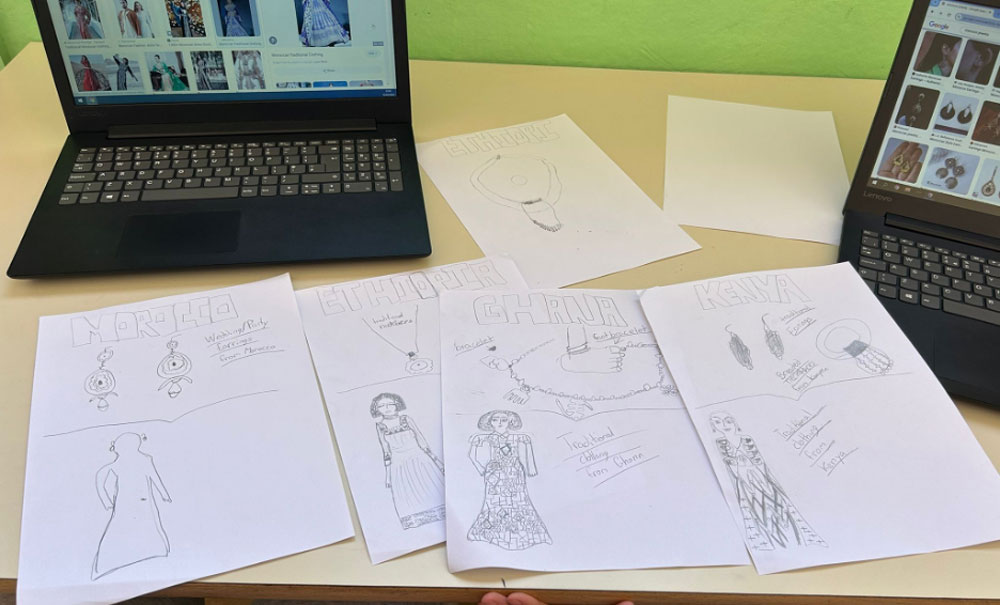
Kindergarten students with their teacher, Kimberly Wong, explored the world of dance. Students followed Maori Haka dancers, amongst others, through videos, music, and storytelling. (Photo source: Verdala International School)
--------------------------------------------------------------
At Verdala International School (VIS), we are in the third year of implementing our school-wide Diversity, Inclusion, and Well-Being (DIW) calendar, with each month highlighting a different theme. As educators, we hope to foster a collective understanding and develop empathy toward all people from an early age. With our DIW calendar, VIS is taking a responsive approach to diversity topics. Our school recognizes that some groups of people—including those identifying as Black, Indigenous, and People of Color (BIPOC), women, and LGBTQA+—are often not seen or celebrated in our curriculum. For instance, a few years ago, the Grade 4 classes did a unit on inventions, where each student had to research a famous inventor. The teachers took a neutral approach in this inquiry, providing no parameters on whom to learn about. It turned out that each student chose an inventor who was a white man. We realized a neutral approach did not lead to the diversity we value in our school. So as an elementary school, we took a responsive approach with our Friday Focus program. For one hour each week, every grade has dedicated time to unpack the inequities explicitly and inquisitively in our world and take steps to represent and learn about diversity.
During our Friday Focus program in elementary, a typical approach is to begin with an entry point—a hook to draw the students' attention and provide a big-picture understanding of the topic—followed by two to four weeks of “student voice and choice” centering on the DIW theme. The Friday Focus monthly champions provide suggestions and resources for inquiries to classes and students. Through this approach, we aim to encourage students to explore the DIW theme in a way that is meaningful and interesting for them.
Year One: BIPOC and Racism
Our first year's entry point focused on amplifying the experiences of BIPOC members of our school community while identifying key terms such as Black, Indigenous, People of Color, race, racism, and stereotypes. After briefly explaining these terms, we invited several BIPOC guest speakers from our school community, drawing on staff and student experiences. In their presentations, they shared examples of why celebrating BIPOC is important and how they have faced issues of racism in schooling and the local community. Following this, all students had three weeks to explore how they could learn about people from the BIPOC community.
Overall, this month was considered a success. It was special knowing that each student, from our earliest learners to our Grade 5s, was exploring BIPOC. However, some questions and concerns were raised along the way. For instance, there was concern from staff that by talking about these issues, we were making the students hyper-aware of race, risking putting people into boxes. Furthermore, after our introduction to the topic, one student of color was under the impression that other students and the world would be mean to them because of how they are seen. As champions, this comment was disheartening. In our attempts to create conversations challenging racial inequalities, at least one student’s takeaway was that the world would be unkind to people who looked like them. We questioned how, as a school, we get students to challenge their biases without making students feel discriminated against or reduced to a label.
Year Two: Shift from Racism to Representation
In response to what we learned, for our second year, we shifted our focus towards a more celebratory view of BIPOC contributions and stories, aiming to highlight joy, achievements, and representation. The fine line between celebrating diversity and simplifying the complex construct of race for an elementary-aged audience became a point of reflection, especially after the first activity of the month. In our entry point, we asked every class to conduct a 20-minute examination of how BIPOC individuals are represented in their classroom libraries. Although the goal was to explore how BIPOC individuals are underrepresented, in some instances it unexpectedly led to discussions about categorizing people by perceived race. It was somewhat troubling to see students holding up books, questioning if the characters looked white, black, Indigenous, or a person of color. The aim was to focus on representation, but it sometimes felt as though it was more about categorizing people into boxes, prompting us to deepen our reflection on how we approach racial diversity. Nevertheless, this month still provided a powerful opportunity to celebrate BIPOC joy and representation in a more positive light compared to year one’s focus on racism.

In Grade 2, some students' inquiries into different cultures led them to explore origami, the art of paper-folding originating from Japan. (Photo source: VIS)
Year Three: Broadening the Conversation From BIPOC to a Wider Lens on Culture and Empathy
In our third year, we transitioned from focusing on BIPOC to embracing a theme of racial and cultural empathy. By reassessing our emphasis on Black, Indigenous, and People of Color, we recognized from the previous year's experiences that such a focus might unintentionally prompt students to categorize individuals. Consequently, we opted to redirect our efforts towards nurturing racial and cultural empathy. This new direction was designed to educate students on racial and cultural diversity without resorting to categorization.
The guiding question for this month was, "How can we develop empathy for different races and cultures?" This allowed students the chance to express their views and choose their learning activities. In the lower elementary level, the inquiry typically involved the whole class jointly exploring various racialized ethnic groups and cultures. In the upper elementary grades, many students pursued independent projects to delve deeper into these themes.
We regard the shift from a BIPOC-centric approach to one that highlights racial and cultural empathy as a positive development. Nonetheless, we remain alert to the possibility that students might still, unintentionally, view race as a justification for categorizing people, something which continues to be a point of concern for us. By explicitly stating “different races” in our guiding question, students may have inadvertently been led to the aforementioned categorization we had hoped to avoid. It remains a careful learning experience for us, as well as our students. Through further exposure and representation, we are optimistic that students will develop a deeper understanding of our shared humanity and the significance of confronting biases and stereotypes.
Two Grade 5 students researched and illustrated various styles of traditional dresses from different countries in Africa. (Photo source: VIS)
Reflection
Reflecting on the past three years, each phase has brought its own lessons and challenges; from directly confronting racism to celebrating diversity and broadening our thematic focus, our journey has been one of continual growth and adaptation. We've learned that discussions on race and diversity are multifaceted and require a nuanced approach, guiding our efforts to foster an environment of inclusivity and understanding.
While the theme of the third year’s Friday Focus centered on representing diverse racial individuals and groups, questions still remain regarding the best approaches for teaching children about stereotypes and their own racial biases. Despite extensive research showing that children develop racial biases at a young age, the optimal timing and methods for introducing these topics to students are still under exploration. These questions are central to our ongoing reflection and exploration on this journey.
Our elementary school’s Friday Focus program's strength lies in empowering students with “voice and choice” in their learning. This approach gives students the responsibility to guide their learning, exploring often underrepresented peoples and cultures through activities like reading diverse books, creating posters, staging plays, and celebrating various traditions and holidays.
As we advance on this path, our experiences at Verdala International School underscore the significance of reflection, openness, and a commitment to continually evolving our approach. By celebrating diversity and fostering an understanding of humanity's rich differences, we have established a foundation for a more inclusive and empathetic future for all our students.
These issues are also deeply intertwined with the experiences of numerous teachers and students throughout their school careers. For many in our school community, these Friday Focus topics hold profound personal significance. It is precisely because these themes are so deeply personal that our passion for incorporating them into our curriculum is heightened. As educators, our aim is to cultivate a collective understanding and instill empathy towards all people from an early age.
By sharing our story, we aim to provide insights and reflections that resonate with others on similar paths, encouraging a dialogue that deepens our collective understanding and approach to celebrating diversity in education.
--------------------------------------------------------------
Michael Neumann is an elementary Assistant Principal at Verdala International School, Malta.
X - michaelinschool
LinkedIn: https://www.linkedin.com/in/michaelneumann2/
Kimberly Wong is a kindergarten teacher at Verdala International School, Malta.
LinkedIn: https://www.linkedin.com/in/kimberly-wong-82293593/